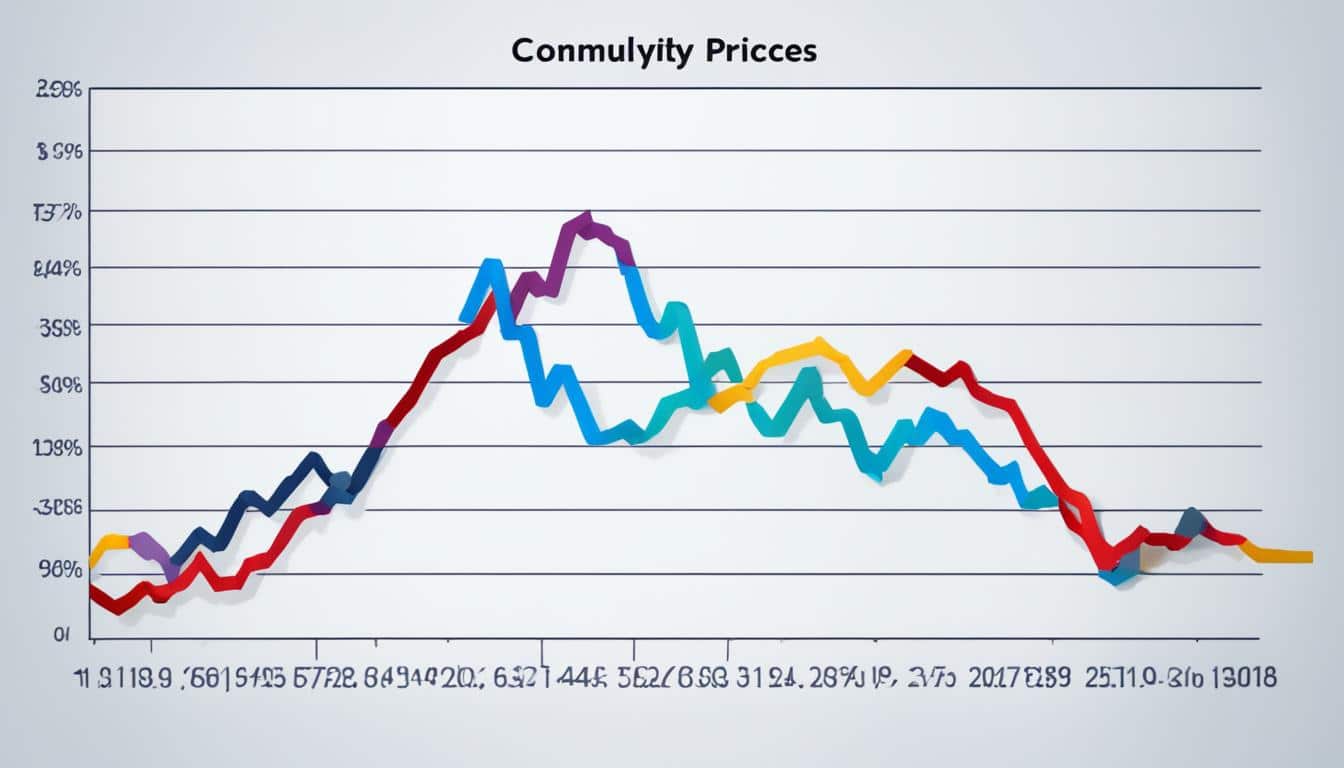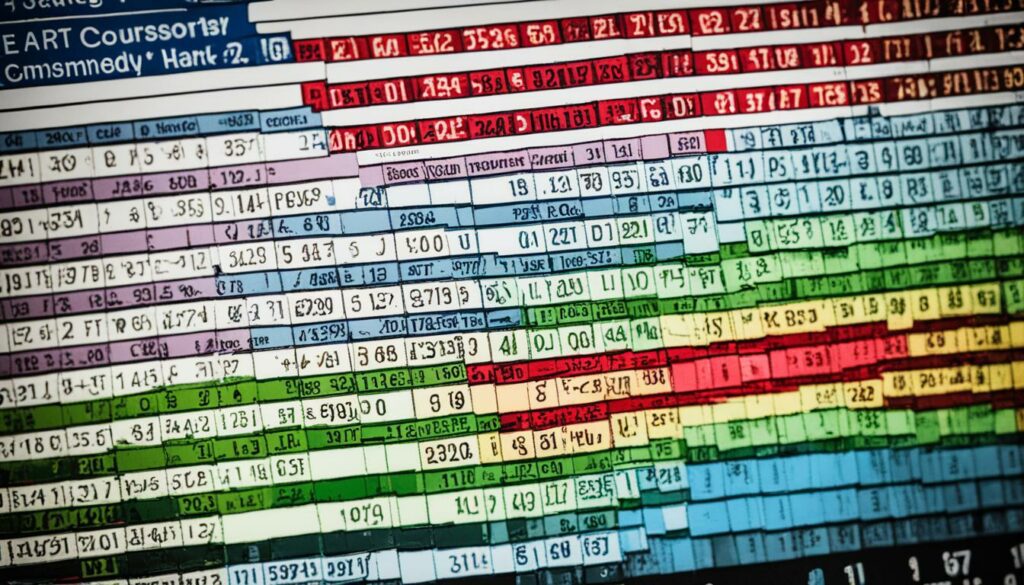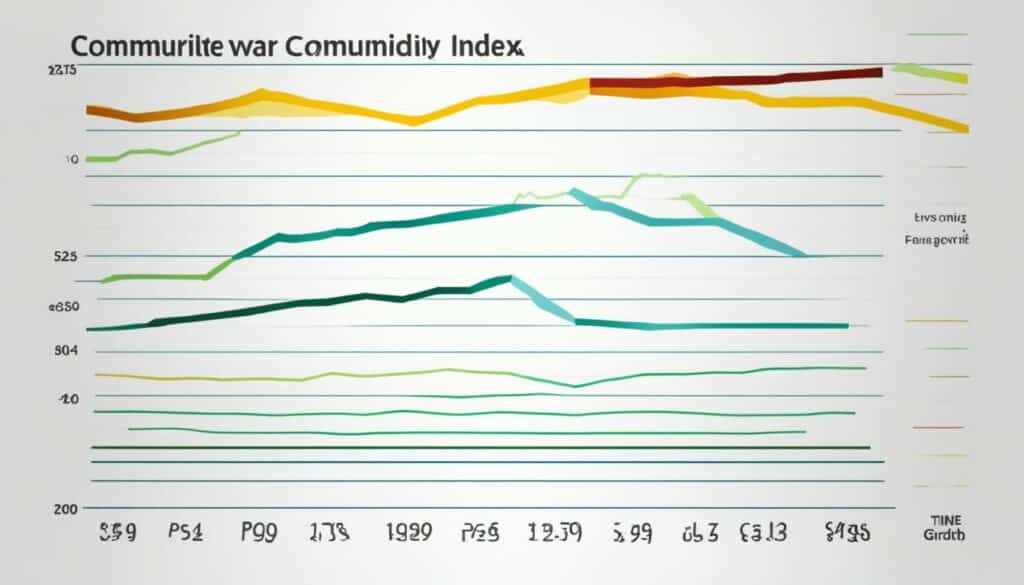Menu

Between 1970 and 2015, the returns on the Bloomberg Commodity Index didn’t closely match U.S. equities or global bonds. This difference shows how commodities act uniquely in finance. It’s vital for investors and analysts to understand these trends.
It’s crucial to follow commodity price index trends for wise investment choices. These indices show us how the economy is doing. Commodity prices might go up when inflation rises, offering a way to protect investments from it. But, the prices can move a lot, so it’s important to plan smartly.
Since the 1990s, investing in commodities has become more varied. Now, there are more ways to include them in investment portfolios. Knowing about global commodity trends helps build a strategy that deals well with price changes and takes advantage of new chances.
The commodity price index shows how prices of many items change in the world market. It helps us see trends in the commodity market and the economy’s health. This index is very important and tells us a lot.
A commodity price index follows the prices of a group of goods over time. It helps show the importance of goods in the world’s economy. The Goldman Sachs Commodity Index (GSCI) is an example. It started in 1991 and later became the S&P GSCI. By watching these, experts and investors learn about the economy.
These indices watch many raw materials. They put them in three main groups:
These goods are very important for the whole world, showing us a lot about our economy. There are other major indices too, like the Bloomberg Commodity Index. They also give us a big-picture look at prices worldwide.
The world’s commodity prices are changing a lot. Market analysis shows a general decrease in prices. The World Bank predicts a 4 percent drop in 2024, after a big 24 percent fall in 2023. This points to an improving economic situation in the next years.
Energy prices are set to go down by almost 5 percent in 2024 but then stay steady in 2025. This is expected to come alongside an average oil price of $81 per barrel in 2024. It’s a bit lower than the $84 per barrel in 2023. In Europe, natural gas prices might drop by 4 percent next year, maybe because of mix-ups at LNG terminals and how the market’s doing.

In agriculture, prices are also likely to go down thanks to more crops because of good weather. In 2023, the prices dropped by 2 percent in the third quarter compared to 2022. The trend is expected to continue in 2024 and 2025.
Metal prices are a bit all over the place. A 2 percent fall was seen in Q3 2023. But, 2024 might bring about a 5 percent drop due to lower demand. However, things should brighten up in 2025 with a predicted 6 percent rise. Metals like copper and aluminium are in demand thanks to clean energy projects. Because of this, their usage has gone up a lot, leading to more investing.
There was a sudden jump in crude oil prices in Q3 2023, from $72 to over $90 per barrel. Many factors played a part in this, like OPEC+ cutting down on production and tensions around the world. But, by the end of November 2023, Brent oil prices had fallen to $83 per barrel. This quick change shows how unpredictable the market can be.
| Commodity | Price Change Q3 2023 | Forecast 2024 | Forecast 2025 |
|---|---|---|---|
| Oil | +5% | -$3/bbl | Stable |
| Natural Gas (Europe) | High | -4% | TBD |
| Agriculture | -2% | -2% | -2% |
| Metals | -2% | -5% | +6% |
*Commodity price analysis* suggests a general slowing down, with prices well below 2022’s peak. Different commodities are performing in various ways. This shows how complex the global market is, with changing supplies and demands. For example, while food prices are up by 2.2 percent, energy costs are still causing big changes.
It’s really important to keep up with the world’s commodity prices. Knowing the current trends and future predictions is key to making smart moves. With the economy and world events affecting prices, staying informed helps everyone involved in these markets.
Studying past commodity prices can teach us a lot about the market’s journey, especially when big economic events hit. Looking at times from before the pandemic to the current recovery helps us see how global disruptions, like the COVID-19, have changed things.
Before the pandemic, commodity prices mainly followed steady demand and supply chains. Take cocoa beans; their prices were usually stable but went up at certain times. Yet, as tensions between countries grew and trade policies changed, market stability wavered. This change led to natural gas prices, usually steady, becoming more unpredictable.
After the pandemic’s peak, the need for essential goods shot up. This saw prices hike significantly. The Commodity Beverage Price Index climbed by 35.61% over a year. Also, extra virgin olive oil became 70.75% more expensive, showing how shifts in how things were supplied and used raised their costs. However, natural gas prices went down by 45.91% during the same period.
COVID-19 hit commodity prices hard, creating wild ups and downs. For example, cocoa beans’ prices surged by 109.81% as their supply faltered. But, bananas got cheaper, dropping by 5.42%. This shows how different goods were affected. Zinc, an industrial metal, saw its price fall by 24.72% as construction and making things stopped for a while.
Looking back at how commodity prices have moved, from before the pandemic till now, shows us the hurdles they’ve faced. The changes brought by COVID-19 are clearly visible. It’s interesting and important to think about these trends to understand our current situation better.
Commodity prices can change quickly because of many factors. It’s key to know these if you trade or invest in commodities. This knowledge can help you understand the market better.
World events can really shake up commodity prices. Things like war, political problems, and export bans can mess up how goods get to market. For example, big groups like OPEC can change oil prices just by adjusting how much they make.
The simple rule of supply and demand keeps commodity prices in check. If there’s lots of something but not many buyers, the price drops. But if people want a lot and there’s not enough, prices go up. This rule shows itself in every market, from foods like corn, to metals, to energy.
| Commodity | Exchange | Examples |
|---|---|---|
| Energy Products | CME, ICE | Oil, Natural Gas, Gasoline |
| Agricultural Products | CME | Corn, Soybeans, Wheat |
| Soft Commodities | ICE | Cotton, Coffee, Rice |
| Metals | LME | Gold |
People who buy and sell these goods need to watch the futures market. This is where they see what prices might do in the future. It helps them make smart moves to protect their money.
Weather has a big effect on goods such as corn, soybeans, and wheat. If the weather’s good, there’s lots of food and the prices can drop. But if there’s a flood or a very dry season, food can become scarce and prices will rise. And big disasters can cause even wider price swings.

In short, knowing about these factors helps people investing in commodities to stay sharp. They can make better choices thanks to understanding how politics, the basics of buying and selling, and nature itself can impact prices.
Global commodity prices are always changing. This offers both chances and risks to investors. We will look at what’s expected for agriculture, energy, and metals. This gives us a big picture of the years ahead.
There will likely be a small drop in food prices. This is because we are getting better at growing crops. For example, soybean production in Argentina is up, helping to balance out lower quantities in Brazil.
In the 2023-2024 season, corn production worldwide is expected to grow by 6.6%. This and stable food pricing will happen against a backdrop of trade tensions and climate change.
The World Bank thinks energy prices will fall by nearly 5% in 2024. After that, they should even out in 2025. Oil prices are set to finish 2023 at over $90 per barrel but may dip to $81 in 2024.
Prices for natural gas in Europe and the U.S. could also go down. This is due to warmer winters impacting demand and the growth of green energy. Companies like Chesapeake Energy are reducing their output. This will help manage prices better.
Metal prices might drop in 2024. But then, a strong comeback is expected in 2025 with a 6% rise.
Copper prices should notably increase by 5% in 2024 due to the demand for green technology. Aluminium might see a 2% bump in 2024 and another 4% in 2025. This is driven by more electric cars and green energy projects.
But, market for metals used in electric cars may become more unstable due to their growing popularity.
Investors need to keep track of many areas to do well in this changing market. By understanding agriculture, energy, and metal trends, they can make wise choices.
For every seasoned investor, knowing how economic indicators affect commodity prices is a must. They give us key insights that help us understand the ups and downs of commodities. This knowledge is vital for anyone looking to delve into the market.

Inflation significantly impacts commodity prices. If inflation goes up, the value of money drops. This makes both inflation and commodity prices rise.
The Consumer Confidence Index (CCI) shows how people change their buying habits when prices go up. The Purchasing Managers Index (PMI) hints at GDP growth. As GDP and inflation move, so does the price of commodities. So, diving deep into these numbers is important for staying ahead in the market.
Interest rates also play a big part in the prices of commodities. When interest rates are high, a country’s money gets stronger. This might lower commodity prices. But, things are not always that simple.
For example, the Monthly Report on Durable Goods tells us about future purchasing power. The Beige Book by the Federal Reserve gives clues about the economy and how rates affect it.
Below is a table showing how different economic indicators affect commodity prices:
| Economic Indicator | Description | Impact on Commodity Prices |
|---|---|---|
| Consumer Confidence Index (CCI) | Tracks how confident people are about their financial future. | If confidence is high, more people spend money, which can raise commodity prices. |
| Purchasing Managers Index (PMI) | Forecasts the growth of the economy. | A high PMI means the economy is strong. This can increase the demand and price of commodities. |
| Monthly New Residential Construction | Gives an early look at the business cycle. | More building means more need for materials, driving up prices of those commodities. |
| Durable Goods Orders | Shows future trends in manufacturing. | More orders point to more use of commodities in making goods. |
| Interest Rates | Govern the cost of borrowing money. | If rates are high, a country’s currency might get stronger, lowering commodity prices. |
Understanding how economic indicators link to commodity prices is key to smart investing. By watching these indicators closely, we can predict the market better. This, in turn, helps us make wiser investment choices.
Global trade policies can greatly change the prices of goods like wheat and maize. They do this by shaping how freely these goods can move across the world. This part will look into the effects of rules like economic sanctions and trade deals on global trading, focusing on these two key crops.
From 2005 to 2017, new trade rules often shook up the costs of wheat and maize. These foods are big in the world’s farming and eating scene. Big changes in their future costs during this time showed us how important the amount of stock available is. This can calm down or stir up price swings, based on whether there’s lots or not much stock.
Countries often tweak trade policies to keep their own food prices steady or to protect their markets. But sometimes, these actions can make prices jump around the world, especially when worldwide stock is low. Between 2007 and the middle of 2008, costs of food and fuel jumped by over 50%. This made the impacts of trade rules and sanctions even harder on crop prices.
Poor countries often feel these effects more, because they sell a lot of crops and goods but don’t make much money from them. For nearly a third of these places, these trade shocks can mean falling deeper into poverty. The effects of global trade on prices can make inflation change a lot in different places. And this can weaken the trust in how well their banks manage things.
Big changes in trade rules can also turn up the heat during tough times, like economic crises. At the end of 2008, prices of food and fuel dropped a lot because of these global money problems. But by late 2010 and early 2011, prices shot back up, causing lots of people to become poor. Around 44 million poor people in different countries dropped below the poverty line as a result.
Looking at yearly price changes, we can see clearly how trade rules affect goods. In 2023, for example, prices barely went up by 0.8%. This was way less than in 2021 and 2022, when prices rose much faster. Since October 2023, these changes stayed below 1%, hitting just 0.3% for February 2024.
In the year leading up to February 2024, food prices went up by 2.2%. This is less than the 3.2% inflation rate for everything. But it’s a big part of how the overall cost of living grows, showing the strong impact of these goods.
Looking into commodity investments offers great chances for mixing up your investments and protecting them from inflation. Yet, it comes with its own share of risks like sudden market changes. Balancing these benefits with the risks shows how important a smart approach to trading is.
Investing in commodities can do a lot for your portfolio. They usually move independently from traditional investments. This makes them good for reducing the impact of market shifts. For example, commodities did not change much with U.S. stocks and global bonds from 1970 to 2015.
Commodities can also help protect your investments against rising prices. When inflation goes up, so do the prices of things like oil and food. This makes them a good addition to your mix of investments.
But, remember there are risks. The market for commodities is known for big swings. It can change a lot because of things like wars, changes in what people want, and even the weather. So, there might be times when investing in commodities doesn’t do so well.
To do well in commodities, entering the market the right way is important. You can start by investing in things linked to the prices of commodities, like futures contracts. This can spread out your risk because you’re not just investing in one thing.
Or, try exchange-traded funds (ETFs) that are connected to actual commodities or their futures. This makes it easier for you to trade in commodities without having to directly deal with commodities markets.
Investing in companies that deal with commodities, such as ones that produce oil or food, is another way. This adds a different kind of diversification to your investments. But, remember that how well these stocks do can be tied to the whole stock market, not just to the prices of commodities.
Knowing the pros and cons of investing in commodities is key for anyone looking to start. Use strong entry strategies, and keep an open mind about the market, so you can make the most of commodities in your portfolio.

Commodities offer a unique way to spread your investment risks. They react differently to the economy than stocks and bonds. This means they can help balance your investment game.
Mixing different assets in your portfolio is key to good management. Commodities, like gold, are great when prices rise a lot. But, their value can change a lot. Still, things like oil and copper might not change as much, helping to keep your investments safe.
But, there’s a flip side to investing in commodities. They might not always make money. Yet, when there’s a lot of inflation, their prices often go up. Some commodities, like metals or farm products, move up and down based on different needs.
To balance this, investing in Commodity ETFs or companies can help. It smooths out the ups and downs, helping you win in the long run.
| Commodity | Correlation with Stocks | 2021 Performance |
|---|---|---|
| Oil | 0.47 | 62% (Bloomberg Sub WTI Crude Oil Index) |
| Copper | 0.48 | 27% (Bloomberg Sub Copper Index) |
| Gold | Negative in 40% of months | -4.33% (LBMA Gold Price PM Index) |
Adding commodities to your investments can make your strategy stronger. They help keep your portfolio safe, regardless of the economy’s condition. This way, you can have a more steady mix of investments.
Technological advances have changed how we look at commodity prices. Especially, with the rise of renewable energy and farming tech. These changes have flipped the way we think about commodity markets. They’ve played a key role in changing both supply and demand.

Renewable energy has really shaken up traditional markets. Now, the world is moving to greener, more sustainable energy. This shift has hit fossil fuel prices, like oil and coal, the hardest. With more electric cars on the road, materials like lithium and cobalt are seeing a huge jump in demand for making batteries.
Agriculture is seeing its own tech revolution. Things like precision farming, GMOs, and smart irrigation have made farming more efficient. The result is more crops and a steadier supply. This has made agricultural prices more stable. The role of technology in shaping farming and market trends can’t be overlooked. It’s changing the face of production and distribution.
Volatility in commodity prices is a big issue, especially for developing countries. It shakes up the global market. Prices changing for things like food, fuels, and fertilisers can impact a lot of people. This pushes us to look at market changes closely.
Lots of things can make commodity prices wobble. From big world events to unique market twists, the list is long. For example, from January 2020 to 2023, Brent crude oil prices varied between $23.3 and $120.1 per barrel. In the same period, wheat prices changed from $198.4 to $522.3 per ton.
How much stuff people want vs. how much is available plays a key part. The world’s economy and specific market conditions are also big factors. On average, commodity prices change by 10 to 20 percent yearly. This shows just how shakey these markets can be.
To keep commodity prices steady, businesses and governments need solid financial strategies. Many medium-sized companies are updating how they handle risk. They’re moving from just looking at costs to using new hedging methods to protect themselves.
This can include making long-term deals, buying on the spot market, or using financial tools like futures and options. Brokers and exchanges like Euronext and the Shanghai Futures Exchange are also important for these organisations. Using fixed prices with suppliers and setting price limits can also help avoid big jumps in costs.
| Commodity Group | Price Volatility (Historical) |
|---|---|
| Oil | High |
| Food | Moderate |
| Metals | Moderate |
| Natural Gas | Very High |
Hedging risks is crucial to maintaining stability. These methods work to limit your financial exposure and manage demand. By tweaking your design or product mix, you can rely less on unpredictable commodities. Good procurement means knowing what affects your costs, talking hard with suppliers, and managing risk carefully.
Knowing how commodity prices connect to economic forecasts is key for smart investment choices. This part looks at the ties between these markets and global economy health. It shows how these affect developing countries too.
Global economic signs like energy and agriculture prices tell us a lot. Lower energy prices in 2024 and 2025 hint at challenges in the world economy. Better farming conditions are likely to lower food prices around the globe.

In 2024, Brent crude oil might cost $84 per barrel and then drop to $79 in 2025. Natural gas had a big price drop recently. For instance, in Europe, prices fell by 35%. This shows how closely economies and commodity prices are tied.
Changes in commodity costs really impact developing economies. In the last few years, the number of people lacking food jumped by millions. On a brighter note, metal prices should be stable in 2024. Then, they’ll likely rise a bit in 2025, helping industries in these nations.
The table below summarises critical commodity price projections and their implications for global economic indicators:
| Commodity | 2024 Price Forecast | 2025 Price Forecast | Impact on Emerging Markets |
|---|---|---|---|
| Energy | -3% | -4% | Reduced energy costs can boost industrial growth |
| Agriculture | Ease due to improved supply | Continuous easing | Improved food security |
| Metals | Stable | Slight rise | Industrial expansion opportunities |
| Brent Crude Oil | $84/bbl | $79/bbl | Cost-benefit for oil-importing countries |
| Natural Gas | Half-yearly substantial decrease | Expected gradual increase | Lower energy costs initially, followed by slight rises |
Changes in global commodity trends strongly impact emerging markets. They work as indicators for the world economy’s health. Knowing these impacts helps those involved make better choices.
It’s vital to see how environmental rules affect what we pay for goods. As these rules get stricter, they change how we do business, pushing for greener ways and altering what we buy and sell.
Efforts to battle climate change greatly change how we deal with goods. From 2004 to 2015, farming caused over 90% of tree losses. To soften this blow, rules now push for eco-friendly ways of sourcing products. The idea is to make sure we don’t harm the planet too much.
Where you are affects how easy it is to find space for farming. This depends on local tech and rules. Places like the Amazon and the Congo are hit hard, needing to watch how they use their land.
To fight climate change, there’s a focus on carbon trading. This puts a money cost on polluting, making everyone think green. The effect of changing prices on available land is quite small, showing how hard it is to balance.
Different areas feel this demand for green in different ways, affecting farmed land. This highlights the need for strong rules. We must find a balance that helps the planet without harming our economy too much.
New ways of making and using goods, like green chemistry, suggest a brighter future. These ideas hint at a big change in how we deal with our products. With the right focus on rules, we could see some big, green steps forward.
Knowing the commodity market well is important for smart investing. We’ve looked into key parts of the commodity price index and its trends here. The World Bank’s index fell by almost 24 percent in 2023 and is likely to go down by another 4 percent in 2024. Oil prices jumped from $72 up to more than $90 in the third quarter of 2023. The price of Urals went above the G7’s limit too.
Changes in natural gas prices have caught a lot of attention as well. In Europe, gas prices are expected to decrease by 68 percent in 2023 and another 4 percent in 2024. The US might see a 20 percent decrease in gas prices next year. Prices for agricultural commodities are dropping. They went down by 2 percent in 2023 Q3 and are expected to fall by another 2 percent in 2024. Food costs dropped by 6 percent, more than agricultural prices, in the past year. Base metal prices also went down by 2 percent in 2023 Q3, and a 5 percent drop is foreseen for 2024.
The increased use of electric cars has led to growing demands for minerals like cobalt, lithium, and molybdenum. Likewise, there’s been a 28 percent rise in investments in clean energy from 2021 to 2023. Studies have shown a link between commodity price cycles and consumer prices. However, this link is more about quality than clear numbers. While some experts think commodity prices show inflation forecasts, others disagree. The use of these prices to predict inflation in the G7 nations is still uncertain. This shows how difficult it is to make precise forecasts.
In summary, making the right investment moves means keeping an eye on these market trends. This report has highlighted the importance of staying informed about commodity prices and their impacts. Understanding these analyses will help investors better manage the challenges in commodity markets.
A commodity price index tracks how the prices of different goods change over time. It’s crucial because it helps us understand the health of the world’s economies. This, in turn, guides investors and analysts in making smart choices about where to put their money.
The index covers broad categories like food, energy, and precious metals. It also looks at things such as cotton and investment vehicles tied to these goods.
Experts look at many things to understand the current prices. These include how much people want, political issues, how much is made, and key economic numbers. These details help to spot trends and understand why prices change.
In the lead-up to the pandemic, things remained fairly steady. Demand was consistent, and supply chains worked smoothly. Prices would move slightly due to world events and supply and demand.
COVID-19 turned the market upside down. Demand dropped, and factories closed. This led to cheaper prices, but things got unpredictable as recovery efforts started.
Big events worldwide, how much is wanted versus how much is available, plus the weather or natural disasters, these shake up prices. Such things make sure prices can change a lot.
Analysts are looking at what prices in farming, energy, and metals might do in the years ahead. They consider what’s happening now, expect future world events, and think about supplies. All this helps to guess where prices might go.
Things like inflation and interest rates can change how much commodities cost. Generally, when the economy isn’t doing well, these goods can become more attractive. So, investors need to watch these trends closely when making plans.
Trade rules like tariffs and agreements can greatly impact prices, as they control who can buy and sell. They are a key part of the world’s trading scene and play a big role in what commodities cost.
Putting money in goods can keep a portfolio strong against inflation. Still, these markets also offer risks due to their up-and-down nature. Knowing the market well and analysing trends are key to managing these risks.
Goods offer a way to lower risk in a portfolio because they don’t always move up or down with stocks and bonds. This can help even out how the investments perform over time.
Advances in clean energy and farming are changing the game. They’re affecting how much we demand and produce certain goods, like those needed for electric cars.
Many factors lead to prices jumping all over, like political fights and bad weather. To stay steady, people use tools to protect their investments from sudden changes.
The index can tell us a lot about the world’s financial well-being. It’s particularly important for places still growing. The index is like a thermometer for the global economy.
Green rules are set to change how much goods cost. These policies help make sure we produce and trade in ways that help the planet, and this will shape the future costs of goods.